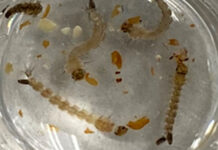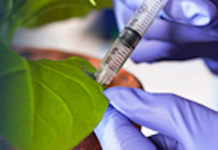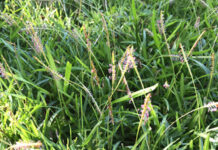If you celebrate Easter, chances are you’ll enjoy more than your fair share of chocolate on Sunday. And while those delicious bunnies, eggs and other goodies seem as plentiful as (ahem) baby rabbit production, some experts worry that one day demand for chocolate may exceed supply.
Chocolate is made from cacao beans, and research shows that 20% to 40% of the world’s cacao beans are lost to cacao plant diseases. This presents a major problem as the confectionary industry depends heavily on chocolate. Similarly, chocolate candies are also a major market for U.S. agricultural commodities such as peanuts, almonds, milk, and sugar. Demand for chocolate has been steadily increasing and there is a fear that one day cacao plant diseases may prevent enough cacao bean production to meet consumer need.

Black pod rot is responsible for the greatest production losses in cacao, primarily because it can be found in every region where cacao is commercially grown. The disease is caused by several species of fungal-like organisms called oomycetes that spread rapidly on cacao pods under humid conditions. Within days of being infected, cacao pods turn black and rotten, rendering them useless for harvesting.
There are also several viruses that affect cacao plants. One, the cacao mild mosaic virus (CaMMV) is not believed to affect the cacao pod’s flavor, but it can cause a mosaic pattern on infected pods that leads to the production of abnormally small pods, as well as the loss of entire branches. Once thought to only exist in Trinidad and Tobago, CaMMV was found in Puerto Rico in 2019 by Agricultural Research Service (ARS) Research Plant Pathologist Alina Puig. In 2021, she confirmed CaMMV at the USDA-ARS quarantine greenhouse in Miami, FL.
“We were able to do genetic analysis on the pathogen and figure out its survival characteristics, transmissibility and how it acts differently in certain locations,” said Puig. “Because of this research we can now target specific ways to interrupt the pathogen’s transmission to other cacao plants.”
Dr. Puig developed a molecular test to detect the virus, which has stopped infected plants from being transported to other areas. Once the virus is detected, the infected plants are removed, quarantined, and used for further research. Cacao leaves from various regions are also being tested to determine the distribution of CaMMV in the Americas and whether or not the virus can be transmitted by seed.
Since both diseases can be present in the same geographical areas, ARS is currently researching the implications of possible interactions between black pod rot and CaMMV. Specific attention will be given to symptoms of cross infected plants, initial visual identification of such infections, and whether infection with one disease makes the plant more susceptible to infection with the other. Although diseases reduce the supply of cacao beans, scientists are helping to minimize their impact. ARS research teams in Florida, Hawaii, and Maryland, will continue to work with scientists and farmers throughout 2022 to solve this agricultural challenge and ensure the commercial viability of future cacao crops—not to mention chocolate Easter bunnies!
The Agricultural Research Service is the U.S. Department of Agriculture’s chief scientific in-house research agency. Daily, ARS focuses on solutions to agricultural problems affecting America.











![[VIDEO] Dickies®: Discover Workwear That’s Anything But Uniform](https://turfmagazine.com/wp-content/uploads/2023/06/1647663814-4b1a2a7742790a9b1e97a3b963477850192e1d6a9dfba9b07214a77bae25d6e3-d-218x150.jpg)





























![[VIDEO] Dickies®: Discover Workwear That’s Anything But Uniform](https://turfmagazine.com/wp-content/uploads/2023/06/1647663814-4b1a2a7742790a9b1e97a3b963477850192e1d6a9dfba9b07214a77bae25d6e3-d-324x160.jpg)